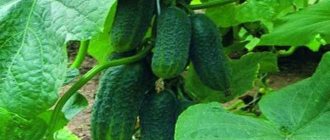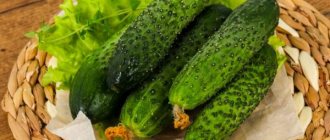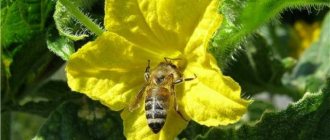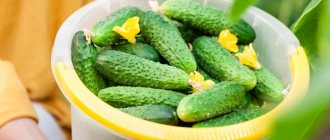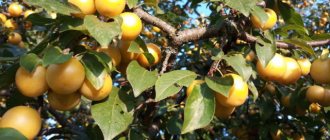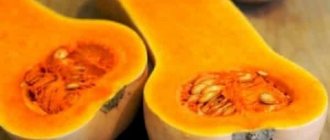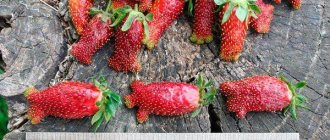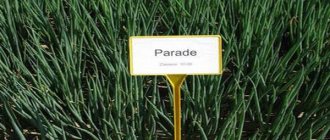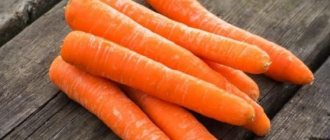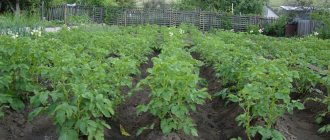Main characteristics of the variety
The biggest advantage of the variety is its early ripening. The fruits are oval in shape, elongated downwards, light green in color with pronounced white stripes that reach half of the green. The surface of the cucumber is covered with multiple small tubercles, as well as black thorns.
Indicators:
- the length of an average greenfish is 10-14 cm;
- diameter 4-5 cm;
- the weight of the fruit itself is 60-70 g.
The leaf blades are wide and have a rich green color. The main lash reaches an average of 100-150 cm.
Attention!
All bee-pollinated varieties have a high content of vitamins, carbohydrates and biologically active substances.
Muromsky 36 has a soft, sweet taste. Thin peel and juicy pulp will allow you to maintain a mild taste even after heat treatment. This variety is often used for preparing salads and snacks, and its small size will make the pickling process easier.
Good compatibility is observed with onions and bell peppers.
Advantages:
- precocity;
- frost resistance;
- possibility of seating in different climatic zones;
- immunity to many diseases and pests;
- low price of seeds;
- several areas of application;
- pleasant aroma and taste.
Disadvantages: small volume of fruiting, low shelf life, does not tolerate drought.
Reviews about the variety from those who planted
Despite their small size, greens from Muromsky 36 are tasty, juicy and aromatic. The variety enjoys well-deserved respect among vegetable growers due to its unpretentiousness, resistance to cold and some cucumber diseases (powdery mildew and bacteriosis).
Can be grown both open and indoors.
Currently, the “Muromsky” variety has been improved by breeders, with the assignment of selection number 36. “Muromsky 36” is the oldest variety included in the state register of breeding achievements.
Productivity and general information
The ripening period will be 40-50 days from the moment of emergence. Productivity is moderate - 2.5-3 kg per 1m2. The fruits grow very quickly. Collection is recommended to be done daily or every other day. If you leave them for a long time, the fruits will quickly outgrow, lose their fresh appearance and turn yellow.
Another problem may be fungal diseases, the plant’s tendency to which begins in September.
The advantages include frost resistance and immunity to diseases:
- powdery mildew;
- bacteriosis
Cucumbers of this variety rarely suffer from pest attacks, however, if this happens, you should use special preparations for control.
Important to remember!
The soil where the seeds will be placed must be fertilized; cucumbers generally require abundant watering.
If there is a dry season and there is not enough moisture, there is a risk that the fruits will grow very small. Therefore, irrigation is carried out at least once a week. Bee-pollinated varieties are contraindicated for growing in the same bed as parthenocarpic varieties, otherwise the greens will grow deformed and have an unsightly “bottle” shape.
How to grow and care
With regular watering and an organized system for draining excess water, cucumbers of the Muromsky-36 variety are not picky about the type of soil, but the quality of the soil affects the quantity of the harvest. Like other crops, this variety “loves” light soil rich in humus. Heavy, dense soils, where water does not drain for a long time or the earth does not warm up well, will negatively affect the quality of the crop. Cucumbers will not “like” acidic, alkaline and poor soils.
Attention!
The best soil composition for Muromsky-36 is considered to be a mixture of soil, peat and humus. Before planting, the beds need to be dug up, thoroughly loosened and, preferably, disinfected with a 7% solution of copper sulfate.
To enrich the soil, fertilizers such as:
- ammonium nitrate 400 g per 1 m2;
- superphosphate;
- potassium sulfate.
Ideally, the predecessors at the site of planting cucumbers were onions, tomatoes, corn, peas, cauliflower or potatoes. You should not plant borage in a place where melons and melons previously grew. Cucumbers should not be planted in one place for more than three years - they become weak and more often susceptible to diseases due to depleted soil.
The main conditions for growing cucumbers are warmth, humidity and lighting. The most suitable temperature for growing is considered to be +24 oC during the day and not lower than +15 at night. At lower temperatures, it is worth considering the use of a greenhouse or greenhouse so as not to destroy the plantings.
Proper watering is an important component of success. It is necessary to moisten as needed, without allowing the soil to dry out, but at least 2-3 times a week, with warm water and, preferably, in the afternoon, when the daytime heat subsides. Too frequent planting of cucumbers is unacceptable:
- if there is insufficient lighting, the ovaries will crumble;
- the plant will weaken and get sick more often.
Cucumber Muromsky-36 blooms best and forms ovaries in conditions of good lighting (at least 11 hours) in warm places without drafts. Planting can be done by seedlings or by direct sowing in the ground.
Selection of ready-made seedlings and their cultivation
Not all gardeners grow seedlings themselves for various reasons. There are several features you need to know to choose healthy planting material:
- the sprout should not be elongated, short, strong, 7-10 mm in diameter;
- the sprout has 4-6 non-cotyledon leaves, of a deep, uniform color (pale color indicates a lack of lighting);
- The root system is well developed and completely encircles the earthen ball.
Attention!
Growing cucumber seedlings on your own is a labor-intensive process. But, with this method of planting, cucumbers will begin to bear fruit earlier!
To successfully grow seedlings, you need to pay special attention to the selection and preparation of planting material. It is optimal to use two-year-old seeds for planting - they produce more fruits and have better germination. To plant in a greenhouse, you need to take mature seedlings (4-5 non-cotyledon leaves); for planting in a garden bed, young seedlings (3 leaves) are better suited.
Recommendations:
- Seeds for seedlings are sown in early May, in peat pots or tablets, individual pots - the root system of cucumbers does not tolerate picking, so it is not advisable to sow in one box.
- Once the seeds are sown, seedlings should be expected within 3-4 days, provided that the temperature is constant and there are no drafts.
- Sprouts require a lot of light; if it is not enough (less than 12 hours of daylight), you should take care of purchasing a phytolamp for plants.
After about 30 days, when 2-3 true leaves appear on the cucumbers (late May - early June), the seedlings can be transplanted into prepared beds.
Landing Features
It is best to grow in beds equipped with a protective film cover. Well-lit areas with protection from the wind and medium-loamy, non-acidic soil are suitable for planting. A favorable period for planting will be the beginning or middle of May, when the average air temperature is +20-25 oC.
Good growth is ensured by soil rich in humus. Before sowing, small holes are dug, then a layer of organic matter is placed there, which is mixed with soil, and a layer of clean soil is laid on top where, ultimately, the cucumbers are planted.
Recommendations:
- the soil must be well fertilized and drained;
- you need to prepare special supports to support the trunk;
- the distance between plants should be at least 10-15 cm.
Immerse the seeds 2-2.5 cm deep into the soil.
Care instructions
To grow this crop, the seedling method is often chosen, but it is better to sow directly into the ground. Large seeds are better suited for cultivation. Before planting, they must be subjected to:
- disinfection;
- pre-sowing warming.
Preliminary treatment will have a beneficial effect on the fruit’s resistance to disease, the speed of ripening, and will help reduce the percentage of barren flowers. When carrying out direct sowing, pay attention to the 40x40 cm pattern. If thickening is observed, you should thin them out as quickly as possible.
After the first five large leaves appear, the stem must be pinched. In this way, the branching of the plant is stimulated, which, in turn, leads to an increase in yield.
Note!
When the temperature outside becomes about +15 °C, you can begin to harden and ventilate the seedlings. At first, 20 minutes will be enough.
Regular rotation of the container with seedlings will help in the formation of normal stems and leaves. You can water in small quantities, but regularly. It is especially important to observe the frequency of moisturizing. Due to lack of water, the fruits may grow small in size with a sharp bitter taste. Stagnation of liquid in containers is also unacceptable. Periodic inspections of the bushes will help to promptly notice and stop the emerging disease.
3-4 weeks after planting, the seedlings can be fed a little. This usually takes 1.5-2 handfuls of compost for each plant. Compost should be placed around the trunk and covered with a layer of mulch. This will help:
- prevent pest attacks;
- maintain sufficient moisture levels;
- improve soil quality.
Cucumbers need to be fertilized throughout the entire fruiting period (about 4 times). The most common and accessible fertilizers are urea, mullein, potassium sulfate and superphosphate.
When feeding seedlings, do not forget about the following rules. Fertilizer can only be applied to moist soil. Feed exclusively in the afternoon. Immediately after applying fertilizer to the leaves, they must be watered. If this is not done, there is a risk of burns.
Growing
The Murom cucumber can be grown both in the central regions with a relatively mild summer season, and in the northern regions with a short and uneven summer.
Well suited for growing in open ground and under film. Medium loamy, breathable soils are considered the best for Murom.
If there is no place left on the site that is well lit by the sun, don’t worry - the Murom cucumber grows well in partial shade.
Cucumbers are grown by sowing seeds in a garden bed or using pre-prepared seedlings.
To obtain strong seedlings, use the following agricultural technology:
- In early May, the seeds are planted to a depth of 0.5 to 1 cm, at a temperature of 23 C.
- Then, when the first shoots appear, the temperature can be reduced to 15 C.
- Seedlings can be planted in a bed prepared in advance in late May or early June, when frost is no longer a concern. The seedlings are about a month old. The soil should be warmed up to 18 C.
- Plant in rows according to a 40x40 cm pattern.
- It is better to cover the seedlings with film.
Murom cucumbers are not advised to pinch when the third leaf begins to appear on the row cucumbers.
Immunity to pests and diseases
Although Muromsky 36 has high immunity to powdery mildew, it is still susceptible to fungal diseases in the second half of August. The following diseases can also affect fruits:
- Root rot. Usually occurs due to the lack of moisture or its excessive amount. If the degree of damage to the bush is high, it will not be possible to save it, but if the disease was noticed at an early stage, you can still try to cut off the affected branches and treat the cuts with ash.
- Perenosporosis. A distinctive feature of this disease is the large light yellow spots that appear on the leaves of the plant. As soon as the first signs of the disease are noticed, you need to urgently remove the affected parts, temporarily stop watering, treat healthy bushes with a fungicide, and then cover them with protective material.
- Cladospariosis (brown spot). A characteristic feature of this is the appearance of small brown ulcers, which occur in the event of excessive moisture or a sharp drop in temperature. In order to combat brown spot, watering should be stopped and the plant should be hidden under a protective film. Oxychom or Bordeaux mixture (copper sulfate solution) is well suited for processing.
- Sclerotinia (or white rot). This disease affects leaves and fruits, covering them with a white coating, which starts the process of rotting. Low temperature will only worsen the disease.
If signs of this disease begin to appear, you need to get rid of the affected areas of the plant and process the cuts. Typically, charcoal is used for processing.
Cucumber Graceful: reviews, variety description, photo
The “Graceful” cucumber variety is rightfully included in the “golden fund” of Soviet vegetable growing. Work on its removal was carried out under the leadership of O.V.
Yurina by specialists from the All-Union Scientific Research Institute for Selection and Seed Production of Vegetable Crops (today – Federal Scientific Center for Vegetable Growing, VNIISSOK village, Moscow region).
The variety was officially registered in the State Registers of Russia (in 1971) and Belarus (in 1974).
The “Graceful” cucumber (pictured) is considered one of the earliest ripening and highest-yielding for open ground
The “Elegant” variety continued the line of cold-resistant cucumbers, such as “Vyaznikovsky 37” and “Muromsky 36”, which were developed back in the 30s of the last century and formed the basis for the further development of domestic selection.
These varieties are zoned and well adapted to the climatic conditions of most regions of Russia, including risky farming zones. Cold tolerance and early ripening allow early planting and a stable harvest in short summer conditions.
Low soil temperature during the first time after planting promotes the development of a powerful root system and slows down the growth of the above-ground part of the plant. This has a positive effect in the future on early maturity, productivity, endurance and resistance to disease.
“Graceful” has all the listed advantages, including high resistance to olive spot (cladosporiosis) and tolerance to bacteriosis.
The variety is recommended for cultivation in open ground and under film covers (in spring greenhouses) in the Northwestern, Central, Volga-Vyatka, Middle Volga, Ural, Western and Eastern Siberian, and Far Eastern regions.
Due to its high yield, the variety is one of the vegetable crops intended for personal and commercial production, and enjoys deserved popularity among amateur gardeners and professional farmers.
| Characteristic | Indicators |
| Ripening time | Early ripening: fruiting begins 40-45 days after the appearance of full shoots |
| Productivity | Up to 5-7 kg/m2 of marketable fruits in open ground |
| Versatility of purpose | Excellent taste of greens, primarily for salad purposes, and also suitable for all types of processing |
| Disease resistance | Resistant to olive spot (cladosporiosis), tolerant to bacteriosis |
Description of the variety
The variety belongs to the bee-pollinated category: for the development of ovaries in female flowers, their fertilization with pollen from male flowers is required. The process of cross-pollination depends on the number and activity of insects.
READ MORE: Cumulus fungicide instructions for use mechanism of action application rate
The variety is characterized by abundant flowering with a sufficiently large number of male flowers, which allows the plant to be used as a pollinator for other varieties
The plant is indeterminate (unlimited in growth), but medium-sized and moderately branched.
It has a mixed type of flowering, with predominantly male flowers located in the leaf axils of the central stem, while female flowers with ovaries appear on the lateral shoots of the first order.
Pinching the central stem is more important for late-ripening varieties in which it is necessary to stimulate branching.
Now many gardeners are of the opinion that it is better not to disturb bee-pollinated cucumbers by pinching them at all.
During the natural growth of the bush, a sufficient amount of barren flowers remains on the central stem for pollination, and the main crop is laid on the side shoots.
You can get acquainted with the advice of an experienced vegetable grower on forming cucumbers on a trellis in open ground by watching the video posted at the end of the article.
Cucumbers should be harvested daily to prevent the greens from overgrowing and not to slow down the formation of new ovaries on the vines
The peel is of medium density, covered with small tubercles and white pubescence. Zelentsy have a beautiful presentation (not prone to overgrowth and yellowing) and high taste: pulp without voids, juicy and crispy, no bitterness.
The variety is declared as a salad variety, but, according to most gardeners, it is suitable for pickling and canning.
Greens for preparing winter preparations are removed at the growth stage, until they reach full size and are not overripe
Among the disadvantages of greens of this variety are sometimes indicated:
- uneven coloring - the presence of white spots on the fruits (white-sided);
- the formation of internal voids during heat treatment during the pickling process;
- peroxidation and softening during salting.
Commercial yield in open ground is quite high - up to 7 kg/m2. The collection of greens should be carried out daily or every other day in order to prevent the fruits from overripening and to direct the plant’s forces to the establishment and filling of new ovaries.
Packages of cucumber seeds of the “Elegant” variety from various manufacturers
Like other bee-pollinated varieties, cucumbers of this variety, left on the vines until natural ripening, produce full-fledged seeds. They can be used for further cultivation, since varietal characteristics are firmly fixed at the genetic level. It is recommended to plant seed material of your own production not the next year, but the 2-3rd year after collection.
